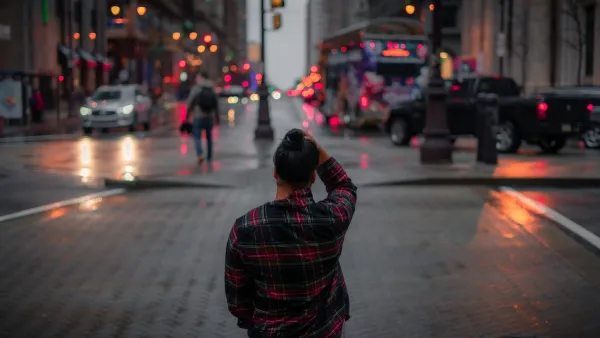In the second part of a four part series on America's pedestrian problem, Tom Vanderbilt evaluates the surprisingly formalized field of pedestrian behavior research, from navigating crowded sidewalks to tripping at the bottom of the stairs.
For someone keen on grasping the nuances of pedestrian behavior, the whole of the United States offers no better destination than New York City. And in the City, Vanderbilt writes, street corners offer some of the best views around:
"Here was a zone of serendipity where people encountered one another beneath the blinking walk man, where they paused to chat before parting, where they formed small convivial islands just as pedestrian flow was surging most strongly... The corner is urban punctuation, a place to pause, essential to the whole civic grammar."
As we discovered last month, social scientists have been analyzing pedestrian behavior since at least the mid-70s, when Jeff Zupan and Boris Pushkarev published Urban Space for Pedestrians. From how crowds pass each other at crosswalks to that awkward game of chicken that pedestrians so often unwittingly play, their research catalogs every minute quirk worth observing. "We were learning by just going out in the field," Zupan says. "If there was something we didn't understand, we went out and took a look."
But the past forty years have taken a considerable share of pedestrian behavior research out of the field, and into the computer. Now, in addition to standing at a crowded escalator and counting how many people opt for the stairs instead, researchers can build immensely complex models to anticipate how people behave under various conditions.
For example, high-density masses of pedestrians (7+ per square meter) begin to behave like a body of fluid, according to engineer John Fruin: "Shock waves can be propagated through the mass, sufficient to... propel them distances of 3 meters or more... People may be literally lifted out of their shoes, and have clothing torn off."
Many aspects of the research have valuable implications for architecture and urban design. Others, like "the way women (in particular) avoid subway grating on the sidewalk," might shed little more than novel insight on the habits we didn't realize we had. Either way, better understanding ourselves as the social, bipedal creatures we are may be an important step in bringing ourselves back to the street.
FULL STORY: Sidewalk Science

Analysis: Cybertruck Fatality Rate Far Exceeds That of Ford Pinto
The Tesla Cybertruck was recalled seven times last year.

National Parks Layoffs Will Cause Communities to Lose Billions
Thousands of essential park workers were laid off this week, just before the busy spring break season.

Retro-silient?: America’s First “Eco-burb,” The Woodlands Turns 50
A master-planned community north of Houston offers lessons on green infrastructure and resilient design, but falls short of its founder’s lofty affordability and walkability goals.

Test News Post 1
This is a summary

Analysis: Cybertruck Fatality Rate Far Exceeds That of Ford Pinto
The Tesla Cybertruck was recalled seven times last year.

Test News Headline 46
Test for the image on the front page.
Urban Design for Planners 1: Software Tools
This six-course series explores essential urban design concepts using open source software and equips planners with the tools they need to participate fully in the urban design process.
Planning for Universal Design
Learn the tools for implementing Universal Design in planning regulations.
EMC Planning Group, Inc.
Planetizen
Planetizen
Mpact (formerly Rail~Volution)
Great Falls Development Authority, Inc.
HUDs Office of Policy Development and Research
NYU Wagner Graduate School of Public Service



























